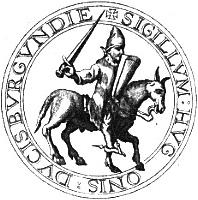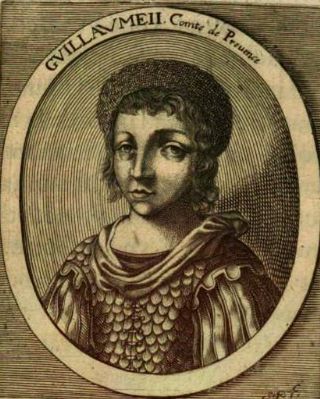Related Research Articles
Gilbertof Chalon was count of Chalon, Autun, Troyes, Avallon and Dijon, and duke of Burgundy between 952 and 956. He became the ruler of the Duchy of Burgundy de facto. By his wife Ermengarde, he had two daughters: Adelais and Liutgarde. Gilbert never managed to maintain the independence of the duchy in the struggles for power of 10th-century France. In 952, he became a vassal of Hugh the Great, count of Paris, and married his oldest daughter, Liutgard, to Hugh's son Otto of Paris. Adelais married Robert of Vermandois.
Henry I, called the Great, was Duke of Burgundy from 965 to his death and Count of Nevers through his first marriage. He is sometimes known as Odo-Henry or Otto-Henry, since his birth name was "Odo" and he only adopted "Henry" on being elected duke of Burgundy.
Otto-William was count of Mâcon, Nevers, and Burgundy.

Hugh II of Burgundy was Duke of Burgundy between 1103 and 1143. Hugh was son of Odo I, Duke of Burgundy. Hugh was selected custos for the monastery of St. Benigne, and this office would be held by his descendants until the end of the twelfth century.

Hugh III was Duke of Burgundy between 1162 and 1192. As duke, Burgundy was invaded by King Philip II and Hugh was forced to sue for peace. Hugh then joined the Third Crusade, distinguishing himself at Arsuf and Acre. He died at Acre in 1192.

Hugh IV of Burgundy was Duke of Burgundy between 1218 and 1272 and from 1266 until his death was titular King of Thessalonica. Hugh was the son of Odo III, Duke of Burgundy and Alice de Vergy.

Hugh, sometimes called Hugh the Great or Hugh of Semur, was the Abbot of Cluny from 1049 until his death. He was one of the most influential leaders of the monastic orders from the Middle Ages.
Fulk II of Anjou, called le Bon was Count of Anjou from 942 to his death.

Geoffrey I of Anjou, known as Grisegonelle, was count of Anjou from 960 to 987.
William I, called the Great, was Count of Burgundy from 1057 to 1087 and Mâcon from 1078 to 1087. He was a son of Renaud I and Alice of Normandy, daughter of Richard II, Duke of Normandy. William was the father of several notable children, including Pope Callixtus II.
Otto IV was the count of the Free County of Burgundy from 1279 until 1303.

William II, called the Pious, was the Count of Provence.
Adelaide-Blanche of Anjou(c. 940 –1026) was, by her successive marriages, countess of Gévaudan and Forez, of Toulouse, of Provence, and of Burgundy, and queen of Aquitaine. She was the regent of Gevaudan during the minority of her sons in the 960s, and the regent of Provence during the minority of her son from 994 until 999.
The Bosonids were a dynasty of Carolingian era dukes, counts, bishops and knights descended from Boso the Elder. Eventually they married into the Carolingian dynasty and produced kings and an emperor of the Frankish Empire.

John, called the Old (l'Antique), was a French nobleman, the Count of Auxonne and Chalon-sur-Saône in his own right and regent in right of his son, Hugh III, Count of Burgundy. In contemporary documents, he was sometimes called "Count of Burgundy", as by King William of Germany in 1251.
Hugh of Chalon was a member of the House of Chalon. He was Count of Chalon and Bishop of Auxerre.
Venerable Lambert I was the count–bishop of Langres from 1016 until his death. He is sometimes called "Lambert of Vignory", but this is a result of confusion with bishop Lambert II. Nothing certain is known of his family, save that he had a married sister named Letgardis. Lambert was a cathedral provost under his predecessor, Bruno.
Henry of Burgundy, called the Gallant, was the eldest surviving son and heir of Robert I, Duke of Burgundy, second son of Robert II of France, and his wife, Helie of Semur, granddaughter of Henry I, Duke of Burgundy. Little is known about his life. He died shortly before his father and was never duke himself.

Stephen II from the House of Ivrea was Count of Auxonne (1173–1237). He was Stephen II in his House and Stephen I as count of Auxonne.
Gerberga, Otto-William's mother, was, by her successive marriages, queen of Italy, margravine of Ivrea (965–970), and duchess of Burgundy (971/5–986/91).
References
- 1 2 3 Settipani 1994, p. 5-63.
- 1 2 3 Bouchard 1987, p. 307-308.
- 1 2 Bijard, p. 35-43.
- ↑ Bouchard 1987, p. 308.
- ↑ Iogna-Prat 2002, p. 90.